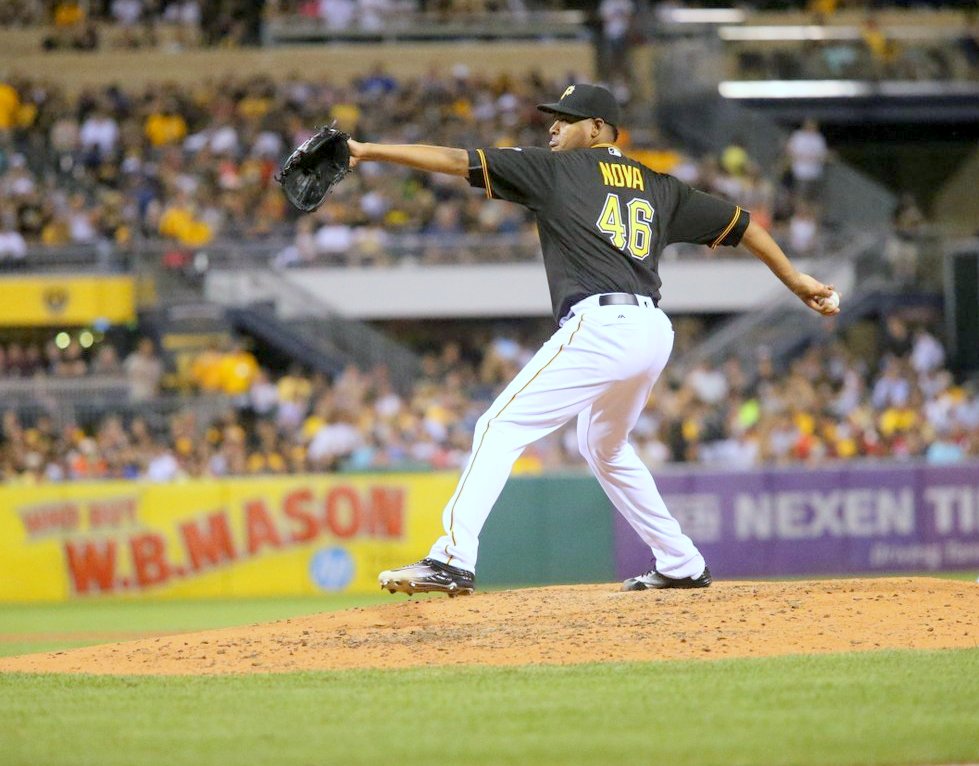Ivan Nova’s trade to the Pittsburgh Pirates at this year’s deadline failed to attract many headlines among the deluge of significant deals completed on the 1st of August. Yet Nova’s performances since arriving in Pittsburgh have brought an under the radar trade firmly into the spotlight. Whilst the Pirates’ playoffs hopes look to have been muted, sitting 6 games back of the 2nd NL wildcard spot, Nova’s performances lend hope to a possible revival of fortunes in 2017. In 7 starts in a Pirates uniform Nova has posted an impressive 5-0 record with a 3.00 ERA, 3.02 FIP and average gamescore (v2) of 62.
Compare that to Nova’s first half of the season in New York as a starter (Nova made 6 relief appearances between April 6th and May 1st) and the apparent improvement since the trade is drastic:
| Starts | Wins | ERA | FIP | GSv2 | BABIP | HR/FB | |
| Yankees | 15 | 6 | 5.15 | 5.54 | 46 | .294 | 22.60% |
| Pirates | 7 | 5 | 3.00 | 3.02 | 62 | .274 | 10.61% |
During the second half of the season Nova ranks 14th in the Majors in ERA, 42nd in FIP and 40th in WAR, trailing only Jameson Taillon for the Pirates in the last two categories. Amazingly for Nova, who struggled with the home-run ball in New York, he now leads the Pirates with a 10.0% HR/FB in the second half.
Nova’s improvement is indisputable and, given his new home in Pittsburgh, perhaps unsurprising. The Pirates have pedigree when it comes to transforming underperforming starters. As Travis Sawchik details in his superb analysis in Big Data Baseball of the Pirates turnaround to become a team in contention, the Pirates front office places significant emphasis on starting pitchers producing groundballs as often as possible. As Sawchik highlights, increasing the groundball percentages of starters such as Jeff Locke, Francisco Liriano and Charlie Morton were vital contributions to the resurgence of all three in 2013.
Nova’s resurgence, however, has been different:
| 4-seam FB% | 2-seam FB% | FB% (both) | Slider% | Curve% | Change% | |
| Yankees | 17.03 | 50.94 | 67.97 | 2.97 | 26.39 | 2.71 |
| Pirates | 8.34 | 52.46 | 60.80 | 1.80 | 30.07 | 7.31 |
Let’s start with Nova’s pitch arsenal. Immediately striking is the reduced reliance upon the fastball, falling from 68% in New York to 61% in Pittsburgh. Meanwhile, the percentage of 2-seamers thrown has counterintuitively increased, most likely favoured by the Pirates for its sinking action. Just as significant, however, is Nova’s increased use of his off-speed stuff with an increased usage for both the curveball and the changeup, surprising for a starter struggling with giving up home-runs. A changing pattern in Nova’s pitch usage is clear, but alone does not offer an explanation for the starter’s upturn in fortunes.
| First Strike% | Zone% | Hit Hard% | Pull% | |
| Yankees | 57.89 | 40.96 | 36.16 | 45.32 |
| Pirates | 68.70 | 47.77 | 33.89 | 40.80 |
Instead we must look to Nova’s plate discipline and pitch control for answers. The results of Nova’s increased use of off-speed stuff are striking. Nova is simply doing a better job of dictating at-bats, rather than having them controlled by the hitter. Crucial is Nova’s improved ability to get ahead in the count, with his first-pitch strike percentage up from 58% to 69%;the average first-strike percentage is 59%. Think about that; more than two thirds of the time Nova moves the count to 0-1. If you consider each at-bat like a hand of blackjack, with the odds of winning change with the outcome of every pitch. Getting ahead gives Nova a significant advantage. Then comes Nova’s improved control throughout the rest of the at-bat, finding the zone on 48% of pitches, compared to just 41% during his time in New York in 2016.
Nova’s new strategy appears to rest on getting ahead in the count early and then clinically shutting down hitters with a blend of off-speed stuff designed to confuse the hitters’ timing and reduce good contact. The results of this are shown above, with Nova’s hard hit% falling from 36% to 34% and percentage of balls pulled (suggesting fewer hitters being early on a pitch they’re sitting on) falling from 45% to 41%.
While Nova’s upturn in performance may benefit from intangible factors such as a change of scenery, reduced pressure from not pitching in New York and improved confidence; his change in strategy is also undeniable. Nova struggled in the first half of 2016 with giving up home runs, the Pirates appear to have found a solution by encouraging Nova to take control of more at-bats by getting ahead in the count as often as possible. Once ahead, Nova has both the off-speed options and sufficient control to put-off hitters’ timings, thereby reducing the number of hard hit balls and, as a result, fewer home-runs.
This theory must also come with a disclaimer; Nova has only made 7 starts for Pittsburgh which could raise some concerns about the sample sizes of data available at this point. Nevertheless, some noticeable trends are beginning to develop in Nova’s favor. It would be no surprise to see Nova, with his first spring training in Pittsburgh under his belt, form a steady part in a resurgent Pirates rotation in 2017.
All statistics are correct prior to last night’s start, when he threw 6 innings of 1 run ball with 11 strikeouts, and are sourced from Fangraphs.com
-Andrew Poole

